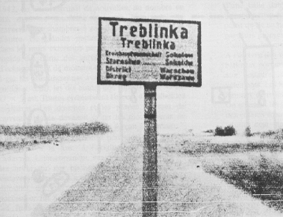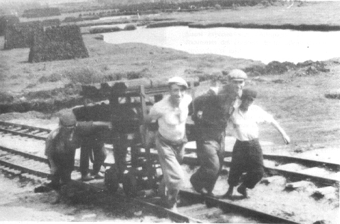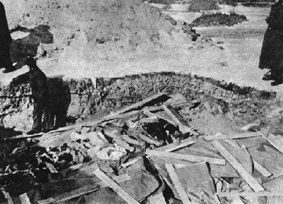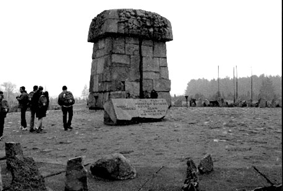Treblinka (Poland)
This article was written by Caren Keller Niss

This article was written by Caren Keller Niss

As with all villages and towns within a twenty to thirty mile radius of this death camp, Treblinka was the final destination for the nearly 2500 Jews of Bransk. They were transported there by train via Bielsk on November 8, 1942.
Treblinka, established in 1941 as a forced labor camp for those accused of crimes by the occupation authorities was located 50 miles northeast of Warsaw, Poland. Within a year of opening what would be referred to as Treblinka I, a second camp was built that would become a critical link in the Third Reich's plan to exterminate the Jewish people. Treblinka II, constructed using German firms, Polish prisoners and Jews, would serve as an elimination center for the Jews of central Europe. Only a mile away from the original camp, this new section would become one of the main extermination centers of the Nazi regime. In his landmark book, "The Destruction of the European Jews," historian Raul Hilberg reports that Jewish labor, in addition to materials, was taken from within the Warsaw ghetto to help build this upper camp.(1 - see footnotes at the end of this text) Opening for operation on July 23, 1942, as the evacuation of the Warsaw ghetto began, the upper camp would house the machinery that would exterminate some 265,000 Jews of Warsaw. Handled with the utmost of secrecy, the perimeter of the camp was surrounded by two barbed wire fences. The inner fence was kept covered with tree branches to conceal the activities within.

One of the very rare photographic document of Treblinka:
prisoners of the "Straflager" preparing a pyre for the burning of the victims
Like all of the other death camps, Treblinka adhered to a specific routine that supported the ruse of resettlement and which minimized the chances of Jewish rebellion or resistance. Details were added in each of the death centers to support the lie of Jewish resettlement. The Star of David on the front wall of Treblinka's gas house, and the Hebrew inscriptions on the curtain that hung at the entrance that read, "This is the gate through which the righteous pass," are just two examples.(2)(3) Variations to the set routine only occurred as was needed to accommodate the physical layout of a particular camp. For instance, the upper camp at Treblinka was unable to receive lengthy trains because of its' short ramps. Therefore, only a few cars at a time were backed in to the camp compound and unloaded. (4)

Mass grave in Treblinka.
As trainloads of five to seven thousand people arrived at the camp the deportees would hear a speech by an SS officer that told them they had arrived at a transit camp. Prisoners were then moved through a selection process in which women and children were separated from the men. Those too sick to walk on their own, unbeknownst to the others, were taken to a pit near the infirmary and shot.(5) All of the victims were then taken to a barracks where their hair was shorn. Postcards were often written by the prisoners, and were later sent by the camp personnel. That encouraged relatives to move east for resettlement. (6) From here they would be directed to the gas chambers.
Treblinka opened with three gas chambers in operation but quickly expanded to at least six. (7) Housed in a brick building, the chambers appeared at first sight to be showers. Pipes attached to the ceiling brought the gas in to the death chambers through what looked like shower heads. (8) Prisoners were told that they were going in to a bath house to be cleansed. They would enter through one door. Once the prisoners were inside the chambers, the order "Ivan, water!" shouted from a German to a Ukrainian guard would begin the gassing. The gassing did not always happen quickly. Because the victims were packed in to the room tightly, there was no room to move around. Consequently, the victims might stand for thirty to forty minutes before they actually died. (9) After death, the bodies would be removed through a door opposite the entrance of the chamber where all the body cavities would be searched for hidden valuables. After this search the bodies would be dragged to mass graves for burial. When the mass graves became a problem, the Germans ordered the graves to be excavated and that the bodies be disposed of in a more efficient way. Starting in the Fall of 1942, this meant dragging the bodies and stacking them on a grid of old railway tracks for burning. (10) Once emptied of the bodies, the chambers would be cleaned and made ready for the next group of prisoners.
While the victims were being gassed, some of the male prisoners emptied and cleaned the train cars of the corpses of those who died en route as well as any objects or dirt that was left behind. Once this work was completed, the train cars left the camp to make room for the next round of rail cars. All the personal belongings, clothes and luggage, that came with the prisoners were gathered and sent to Germany. (11)
Not all of the deportees arriving at Treblinka met their fate in the gas house. Some were forced to work jobs to keep the killing business in motion. They would be used as laborers for a period of days and then selected out for gassing.
The camp was initially supervised by SS-Obersturmfuhrer Imfried Eberl. SS-Obersturmfuhrer Franz Stangl replaced him in August 1942. The camp was staffed by a combination of Germans, Ukrainians and Jewish prisoners. Twenty or thirty SS men served as the core leadership in the camp. Ninety to one hundred and twenty Ukrainians acted as camp guards, security personnel and other jobs like operating the gas chambers. Seven hundred to one thousand Jewish prisoners performed the manual labor, including the work described above as part of the killing process, and these prisoners were expected to tend to the personal needs of the German and Ukrainian staff. (12)
Opening for "business" on July 23, 1942, with the beginning of the evacuation of the Warsaw ghetto, some 245,000 Warsaw Jews and 112,000 Jews from other places in the Warsaw district were murdered in Treblinka by September 21.(13) 337,000 Jews from the Radom district, 35,000 from the Lublin district and 107,000 from the Bialystok district also met their death in Treblinka with 738,000 Jews who had been residents of the General gouvernement. From outside Poland many thousands of Jews were transported to and killed in Treblinka: 7.000 from Slovakia, 8,000 from Theresienstadt concentration camp, 4,000 Jews from Greece, and 7,000 Jews from the Macedonia portion of Bulgaria. In addition to the Jews, some 2,000 gypsies were killed in Treblinka. (14)
There were some acts of resistance in Treblinka. Several incidents by individuals or transports would result in the wounding or death of SS men and Ukrainians. An underground resistance movement existed which included inmates from both camps at Treblinka. The biggest resistance effort came in August 1943. A core group of fifty to seventy men planned to take weapons from the camp armory to destroy the camp installations and allow inmates to flee to the surrounding forests. It was anticipated that once an uprising was begun, many other prisoners would join. While the beginning of the plan went smoothly, a suspicious SS guard forced the resistance in to action sooner than planned. Before the guard, SS officer Kurt Kuttner, could alarm other guards some resistance fighters opened fire and set some camp buildings on fire. Masses of prisoners tried to storm the fence and escape. They were fired upon and mostly killed by guards in the watchtowers and other security forces searching the area. Of the seven hundred and fifty prisoners who tried to escape, only seventy survived to see liberation. (15)
Jews from the Polish Districts of Warsaw, Radom, Bialystok and Lublin as well as others from Theresienstadt concentration camp, Macedonia and the Reich comprised he nearly 750,000 people who would die in the gas chambers of Treblinka between July 1942 and April 1943. (16) Primarily Jews, the victims would often die within two hours of their arrival.
As the Allied forces got closer in the Fall of 1943 evacuation of the camp was begun. Orders were given to destroy the camp so that no traces of its existence would remain. A farm was built on the Treblinka site and it was offered to a Ukrainian to run it for income. (17)
Visitors to Treblinka today are likely to have a very powerful and somewhat eerie experience. Visitors enter the camp through the same spot where deported Jews and others exited the trains. Standing there you face an open field with solid rock structures that serve as tombstones. On each stone is engraved the name of a town and the number of people from that town that were killed by the Nazis at Treblinka. In the center of the field lies a mass grave and a memorial with a big crack in it intended to express the wickedness of the place.

The memorial.
This article was written by Caren Keller Niss based on the writings of:
To learn more about Treblinka or the Holocaust you can read the following books: